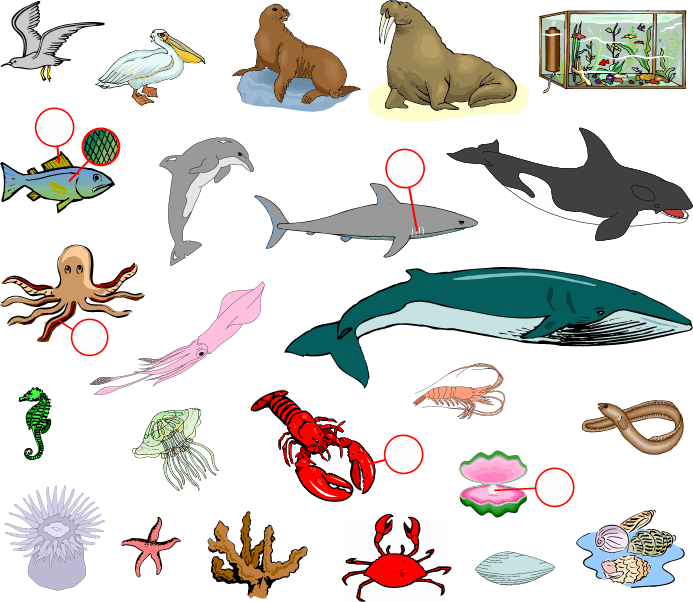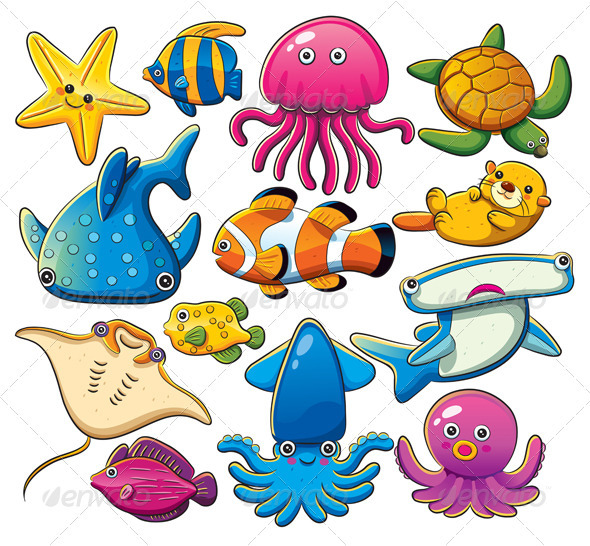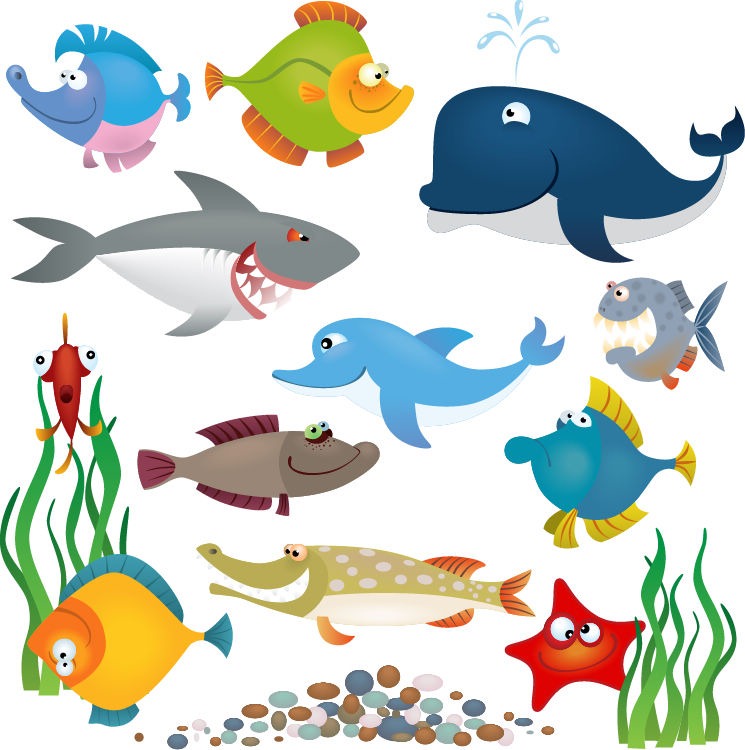Sea Animal Pictures Biography
is the scientific study of organisms in the ocean or other marine or brackish bodies of water. Given that in biology many phyla, families and genera have some species that live in the sea and others that live on land, marine biology classifies species based on the environment rather than on taxonomy. Marine biology differs from marine ecology as marine ecology is focused on how organisms interact with each other and the environment, and biology is the study of the organisms themselves.A large proportion of all life on Earth exists in the ocean. Exactly how large the proportion is unknown, since many ocean species are still to be discovered. The ocean is a complex three-dimensional world[3] covering about 71% of the Earth's surface. Because of its depth it contains about 300 times the habitable volume of the terrestrial habitats on Earth. The habitats studied in marine biology include everything from the tiny layers of surface water in which organisms and abiotic items may be trapped in surface tension between the ocean and atmosphere, to the depths of the oceanic trenches, sometimes 10,000 meters or more beneath the surface of the ocean. Specific habitats include coral reefs, kelp forests, seagrass meadows, the surrounds of seamounts and thermal vents, tidepools, muddy, sandy and rocky bottoms, and the open ocean (pelagic) zone, where solid objects are rare and the surface of the water is the only visible boundary. The organisms studied range from microscopic phytoplankton and zooplankton to huge cetaceans (whales) 30 meters (98 feet) in length.
Marine life is a vast resource, providing food, medicine, and raw materials, in addition to helping to support recreation and tourism all over the world. At a fundamental level, marine life helps determine the very nature of our planet. Marine organisms contribute significantly to the oxygen cycle, and are involved in the regulation of the Earth's climate.[4] Shorelines are in part shaped and protected by marine life, and some marine organisms even help create new land.[5]
Many species are economically important to humans, including food fish (both finfish and shellfish). It is also becoming understood that the well-being of marine organisms and other organisms are linked in very fundamental ways. The human body of knowledge regarding the relationship between life in the sea and important cycles is rapidly growing, with new discoveries being made nearly every day. These cycles include those of matter (such as the carbon cycle) and of air (such as Earth's respiration, and movement of energy through ecosystems including the ocean). Large areas beneath the ocean surface still remain effectively unexplored.
The HMS Challenger during it's pioneer expedition of 1872–76
Main article: History of marine biology
The earliest instances of the study of Marine Biology can be traced back to Aristotle who made several contributions which laid the foundation for many future discoveries and were the first big steps in the early exploration period of the ocean and marine life.[6] British naturalist, Edward Forbes was also a key player in the history of marine biology and is considered by many as the founder of the science of oceanography and marine biology.[7] Overall, the pace of oceanographic and marine biology studies quickly accelerated during the course of the 19th century.
The observations made in the first studies of marine biology fueled the age of discovery and exploration that followed. During this time, a vast amount of knowledge was gained about the life that exists in the oceans of the world. Many voyages contributed significantly to this pool of knowledge. Among some of the most significant is the H.M.S Beagle where Charles Darwin came up with his theories of evolution and on the formation of coral reefs.[8] Another important expedition is the H.M.S Challenger where findings of unexpectedly high species diversity of fauna stimulated much theorizing by population ecologists on how such varieties of life could be maintained in what was thought to be such a hostile environment.[9] This era was extremely important for the history of marine biology but naturalists were still limited in their studies simply because they lacked certain technology that would allow them to accurately examine the species that lurked the deep parts of the oceans.
The creation of marine labs was important because marine scientists had places to conduct research and process their specimens from expeditions. One of the most important marine labs is Woods Hole Oceanographic Institute where scientists stayed and conducted years of significant research and made many important findings.[10] There were also many technological advances that further enhanced the study of marine biology. For example, sound navigation ranging, scuba diving gear, submersibles and remotely operated vehicles, to name a few, are some of the more impactful technologies in marine biology which allowed naturalists to explore depths of the oceans that people once thought never existed[11]
Subfields[edit]
Coral reefs form complex marine ecosystems with tremendous biodiversity.
The marine ecosystem is large, and thus there are many sub-fields of marine biology. Most involve studying specializations of particular animal groups, such as phycology, invertebrate zoology and ichthyology.
Other subfields study the physical effects of continual immersion in sea water and the ocean in general, adaptation to a salty environment, and the effects of changing various oceanic properties on marine life. A subfield of marine biology studies the relationships between oceans and ocean life, and global warming and environmental issues (such as carbon dioxide displacement).
Recent marine biotechnology has focused largely on marine biomolecules, especially proteins, that may have uses in medicine or engineering. Marine environments are the home to many exotic biological materials that may inspire biomimetic materials.
Related fields[edit]
Marine biology is a branch of biology and is closely linked to oceanography. It also encompasses many ideas from ecology. Fisheries science and marine conservation can be considered partial offshoots of marine biology (as well as environmental studies). Marine Chemistry, Physical oceanography and Atmospheric sciences are closely related to this field.
Animals[edit]
Birds[edit]
Main article: Seabird
Birds adapted to living in the marine environment are often referred to as seabirds. Examples include albatross, penguins, gannets, and auks. Although they spend most of their lives in the ocean, species such as gulls can often be found thousands of miles inland.
Fish[edit]
Main article: Fish
See also: Diversity of fish
Fish anatomy includes a two-chambered heart, operculum, swim bladder, scales, fins, lips, eyes and secretory cells that produce mucous. Fish breathe by extracting oxygen from water through their gills. Fins propel and stabilize the fish in the water. Major fishes coming under two categories - Elasmobranchs and teleosts.[clarification needed]
A reported 32,700 species of fish have been described (as of December 2013),[12] more than the combined total of all other vertebrates. About 60% of fish species are saltwater fish.[13]
A crown-of-thorns starfish.
Invertebrates[edit]
Main article: Marine invertebrates
As on land, invertebrates make up a huge portion of all life in the sea. Invertebrate sea life includes Cnidaria such as jellyfish and sea anemones; Ctenophora; sea worms including the phyla Platyhelminthes, Nemertea, Annelida, Sipuncula, Echiura, Chaetognatha, and Phoronida; Mollusca including shellfish, squid, octopus; Arthropoda including Chelicerata and Crustacea; Porifera; Bryozoa; Echinodermata including starfish; and Urochordata including sea squirts or tunicates.










No comments:
Post a Comment